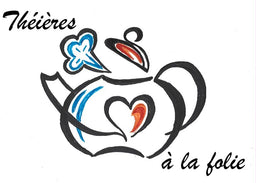Summary :
Or almost! Things fall into place more easily with history.
From tea to teapot, from teapot to silver teapot.
It all starts with tea, which has long been consumed in powdered form in India, Japan and China, often for medicinal purposes. Especially at the time of the Tang dynasty, ground tea was practiced, boiled in a cauldron before being poured into bowls.
Looking for traces of the teapot, we find them between the 13th and 14th century with the Yuan dynasty, based on the model of wine jugs, the principle of infusing leaves begins there. With the Ming dynasty (1368-1644) the teapot was finally used, and continued to evolve. The teapot becomes an essential object, it becomes popular during the following dynasties starting with the Gaiwan a bowl with lid and saucer (which is still used today), and we trace the first creations of small teapots for 1 or 2 people, in the Yixing region with local Zisha clay, the famous purple or purple clay which we still talk about today.
Europeans from the 16th century discovered tea during their travels, they were seduced and quickly felt the need to import it. For its part, Yixing enjoyed enormous success with its teapots and continued to evolve in terms of materials and porcelain took birth and notoriety.
Europeans create trade circuits (East India company) and tea is sold expensive at the beginning of imports, it is reserved for the aristocracy, England will be the most adept and will quickly make it a national drink: who does not know afternoon tea?
In France, the first use of the teapot dates back to the visit of the ambassadors of Siam to the court of Versailles in 1686. Tea is considered precious and is only consumed on auspicious occasions to display the magnificence of royalty. . We were attracted at that time by the "chinoiseries" of decorative European art objects whose aesthetics copied Asian art, a model of singularity and escape.
What about the silver teapot then?
In the 18th century, in Europe, but also spreading around the world, tea, coffee, chocolate also took on a connotation of luxury, and European goldsmiths were quick to react and offer models of teapots and all that can gravitate around, pot, sugar bowl, cups, candy box, etc. Wealthy families do not fail to obtain a silver teapot. In particular the elite of English and Scandinavian households. For the less privileged, pewter is a good compromise.
This silverware is a way for families to consolidate and show off their fortune, or even a reserve that can meet unexpected expenses. Didn't Louis XIV himself give his silverware to be melted down to save the currency?
Silverware often bore the marks of its owner.
In Praise of Silver: Silver has been used in culinary art for thousands of years. Objects have been found in Egyptian tombs dating back 5,000 years. We find tableware belonging to Chinese royalty dating from the 7th century.
Silver is an excellent conductor of heat, so water can be kept hot long after it has been boiled. Water heated in a silver teapot gives a better brewing result, because of the very fine bubbles during boiling. Silver has a bactericidal and fungal power, merchants transported their food and drinks in silver containers in order to preserve them.
Silver is an anti-corrosion metal, does not degrade and is used from generation to generation, it can constitute a heritage.
The silver teapot in Europe or the West
To cite only England, as the quantity of tea spread thanks to the importation of the East India Company, people were able to benefit from it and appreciate it. However, served in cafes, the teapot looks more like a coffee pot, taller and cylindrical.
It was not until Queen Anne came to power in 1702 that teapots came into widespread use, first pear-shaped, then spherical around 1710. The silver teapot became more discreet between 1755 and 1770 , probably because of the very high taxes on tea.
It was only at the end of the 18th century that it returned to the stage, the chiseled silver teapot, is embossed, with motifs of foliage and flowers. Gradually on 4 feet, larger and rounder, then the ivory and wooden handles are gradually replaced by silver as well. There was a period when the shape was polygonal (1815). Then with a collar around the lid appears in the 19th century for the purpose, no doubt, of protecting against overflows. Currently we find these models either real old teapots in antique silver, or imitating these beautiful Victorian and George III eras, at prices however quite high when you have to do with a solid silver teapot, more reasonable when you have to do with a silver-plated teapot.
We can thus trace the course of the old silver teapot for all the countries of Europe with roughly the same pattern. In the same way, the models are perpetuated either in antiquity or by imitation of the past. However, some major brands are releasing some contemporary models, more sober and with a sleek design.
The silver teapot in Asia
The silver teapot already dates back to the time of the Tang dynasty, so from the beginning of the teapot. This was a glorious time for silverware in China. But limited to a restricted hierarchical number of users. The models made were the expression of royalty.
The Japanese trace the origin of tea culture to the Tang dynasty. In fact, monks were sent to China to bring back Buddhist and tea culture during this period. Most tea items originate from China. Then Japan developed the tea ceremony and its own tea cultural identity. Modern iron, silver and gold kettles are used to boil water in Japan
Nowadays, Chinese or Japanese silver teapots are closely related in style, design and production. There are great masters of craftsmanship on both sides. We find the teapot in hammered, engraved or polished silver, the shape of the tetsubin, richly decorated with symbolic motifs dear to Asian culture. The dragon's egg shape is also cherished. We also note undoubtedly the most beautiful teapots, those in cloisonne. The capacities remain small, linked to the culture of the tea ceremony, where we favor the quality of the tea over quantity.
The silver teapot has crossed the ages and continents brilliantly, we see in history that Asia was the cradle of the world of tea, so that Europe then appropriated it, particularly England. Beautiful silver teapots are often a thing of the past; you can find them in antique shops; some major brands continue to produce them in sober and contemporary designs. Asia, for its part, continues to perpetuate its know-how, with remarkable artisans who love their profession, often incognito. The varied, elaborate designs are true objects of art.
Conclusion
The silver teapot is a high-end piece of craftsmanship appreciated by the tea lover, and also the collector who recognizes its timelessness. This one will cross the ages with elegance.
The silver teapot is a perfect combination of art and utility. When we buy a silver teapot made by hand, we are building history with its craftsmen for our future. If the silver teapot can constitute a heritage, let us look to the future, and appropriate real works of art that could constitute the heritage of our children.


